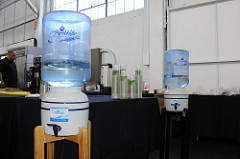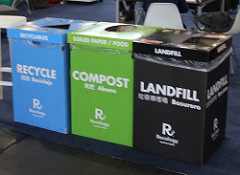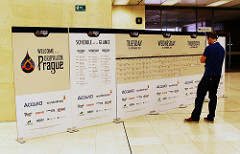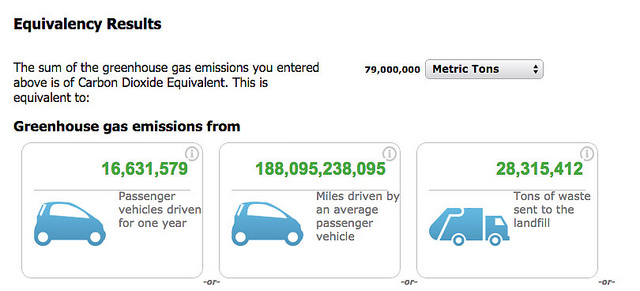Hello, Drupal world! We are thrilled to be able to give you an inside peek at what goes into planning DrupalCons. Throughout 2016, we’ll share a series of posts, and a few webcasts, to show some behind-the-scenes aspects of DrupalCon. First, we met the events team that produces 3 Cons a year. Now, meet the production team that makes DrupalCon a reality.
 The Drupal Association aims to produce DrupalCon conferences in alignment with our commitment to environmental and social responsibility. As the production manager, I have an important role in making sure we make informed purchasing decisions and form strategic partnerships with our venue and vendors. I’d like to share just a few of the things we address behind the scenes during the planning process.
The Drupal Association aims to produce DrupalCon conferences in alignment with our commitment to environmental and social responsibility. As the production manager, I have an important role in making sure we make informed purchasing decisions and form strategic partnerships with our venue and vendors. I’d like to share just a few of the things we address behind the scenes during the planning process.
First Step: Selecting a Venue
The planning for a DrupalCon starts a few years prior to the event date, when we select a venue. Hosting a sustainable event is only possible if the venue’s infrastructure and operations practices are already "green", so vetting the venue is a big criteria.
The good news: For the most part, all new convention centers in the U.S. are built according to LEED standards. By selecting LEED certified buildings we are supporting these principles. Energy efficiency is another criteria we scrutinize: we look for ENERGY STAR® standards. We're often encouraged to see that many convention centers go beyond simply having smart energy management systems -- it is not uncommon to find solar power systems and green roofs. We are also pleased to see a surprising number of bee hives appearing on those living roofs, supporting local bee populations and providing the convention center kitchen with fresh honey.
Each venue comes with a small number of exclusive vendors, and the one with the highest opportunity to affect the sustainability of operations is the in-house caterer. We have the ability to request that our meal and break activities are carried out with the lightest impact possible. We build these requests into our catering contract when we commit to working with the venue.
Catering for 3500+ people for most of a week is a daunting thing to consider. Catering is a complex set of operations that affects our air, land, and water supply, and these activities represent the greatest opportunity for us to make a difference. Here's what we do:
- We request that the caterer source from local farms when possible, resulting in low food miles and lower greenhouse gas emissions. In order be good partners, we often agree on a “chef’s choice” menu. What this means is that the chef does not have to commit to a menu until about 60 days prior to the event, when it is clear what items are abundant and locally available.
-
We aim to conserve our natural resources. To do that we avoid use of non-renewable resources, and live the mantra "Reduce, Reuse, and Recycle" to limit our additions to the community landfill. Here are a few of the ways we lessen our impact:
-
 We request that our beverages be served via bulk containers, such as water bubblers or pitchers of ice tea and lemonade. This avoids what would be the use and disposal of over 10,000 water bottles at each U.S. event, and 5,000 water bottles at our European event.
We request that our beverages be served via bulk containers, such as water bubblers or pitchers of ice tea and lemonade. This avoids what would be the use and disposal of over 10,000 water bottles at each U.S. event, and 5,000 water bottles at our European event. -
We take the box out of the “box lunch.” No matter how recyclable the cardboard is, the box has a useful life of about 5 minutes. We avoid manufacturing energy and pollution, and avoid a large volume of cardboard that needs to be recycled just by saying "No box please.”

- We request biodegradable or compostable serving ware. We also request that recycling containers be placed throughout the venue to divert almost all waste from community landfills. Our goal is to make sure that almost all materials are recycled or composted.
-
Next Steps: Strategic partnerships
After the venue is selected, we set our sights on other strategic partners.
- For our printed materials, we specify to our vendors that they use 100% recyclable materials, and print with FSC-approved paper and organic inks.
- We rent our audio-visual and other equipment rather than purchase it, as this avoids the unnecessary extraction of raw materials and manufacturing waste.
-
 We source many things from vendors in the city we are working in. For example our signage is always printed locally to avoid unnecessary packaging and to reduce emissions generated from transportation. This comes with the added bonus of putting even more money into the local economy, too!
We source many things from vendors in the city we are working in. For example our signage is always printed locally to avoid unnecessary packaging and to reduce emissions generated from transportation. This comes with the added bonus of putting even more money into the local economy, too! - We request that all leftover food be donated to food banks or other agencies that deliver food to those who need it.
- We donate leftover T-shirts and tote bags to local agencies who distribute them to people in need.
Why All Events Should Be Green Events
For those in the community who are curious about why we put so much effort into making DrupalCon as ecologically sustainable as possible, it's important to understand the wider events industry. From public conferences, to industry meetings, to world summits, events are where people gather to announce academic breakthroughs, discuss industry changes and societal challenges, and put forth our best ideas and thought leadership. As our world becomes increasingly connected, it is clear that live events are not going away.
Unfortunately, there is a shadow side to the event industry: large-scale events have a big environmental and social impact. Environmental impacts include landfill waste, toxics, and water usage. Social impacts can involve human and labor rights in a global supply chain.
Carbon emission data can give a sense of the scale of this industry and its footprint. There are 1.8 million meetings (the industry term for any sort of live conference or summit event) in the U.S. alone each year. Meetgreen, a green meetings leader, calculates that each attendee at an average event produces 0.176 metric tons (MT) of CO2 per event day. According to the EPA, in 2012 in the U.S. alone, 225 million people attended meetings. With 225 million participants attending an average of two days per event, that’s 79.2 million MT of CO2 per year. How much is that? According to the EPA, that’s the same amount of CO2 emitted by 16.6 million cars for an entire year, which is more than all the cars currently registered in all of California.

All of us who plan events need to understand how the decisions we make at even the smallest level contribute to a global meeting industry impact. The Drupal Association aims to act on our values by making informed decisions in order to minimize our impact and support vendors and suppliers who are making a difference.
Diana Connolly is the production manager for DrupalCon. She founded the event production company Groundswell Marketing in 1994, after a combined ten years in corporate marketing and the trade show exhibit industry. Her clients are primarily in the technology sector, and range from startups to the Fortune 100. Ms. Connolly has an MBA in Sustainable Enterprise and is passionate about triple bottom line results. You can learn more at Groundswell Marketing, or contact Diana via LinkedIn or e-mail.

Comments
Thanks for the writeup with
Thanks for the writeup with lots of peaks behind the scene. However, it's one thing that interests me more than any, and that is how leftovers beeing dealt with.
I remember when I asking about this at DC Prague in 2013 and the answer was that "~the vendor didn't have any plan in place or means for donating leftovers" (and that "we" as a customer hadn't been pushing for it since.. the vendor hadn't provided any solution).
Anyway, as I understand it, in US there is a much stronger tradition of handling leftover food, in small or big, like the venus that hosts our conferences, and that is a really good thing.
To my point; "We request that all leftover food be donated to food banks or other agencies that deliver food to those who need it." ought to be rephrased to "We demand that..". We definitely are in a position to tell here, and by all means we should.
And it almost goes without saying, this rule applies to every Con, no matter where being hosted.
DrupalCon Prague
Hello Hurricane66,
I am pleased to let you know that at DrupalCon Prague the leftover food was donated to food banks via our catering partner Zatisi. Sorry if that information did not make it out to you and the community.
I am also pleased to report that this is something we "demand" at every venue, and for as long as I've been helping produce them (2009); it has been happening at Con's in the U.S. and Europe.
Cheers!
Diana